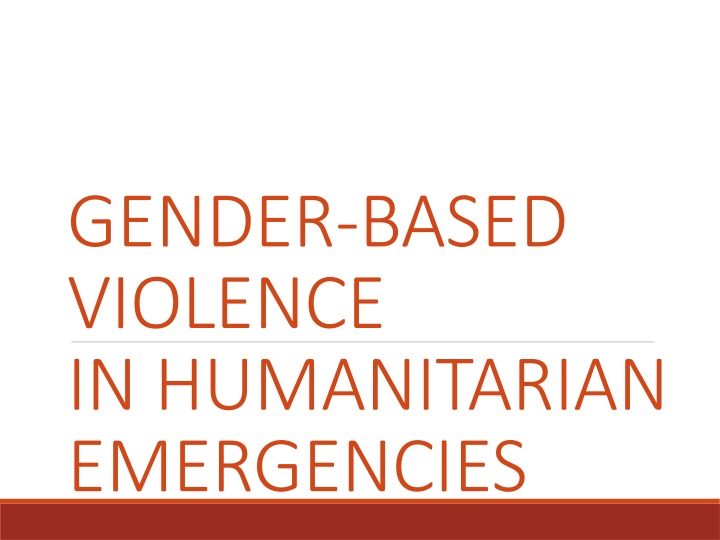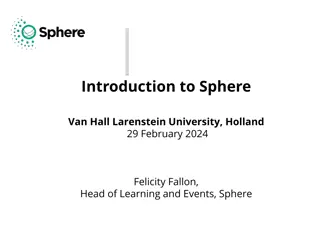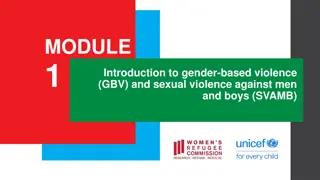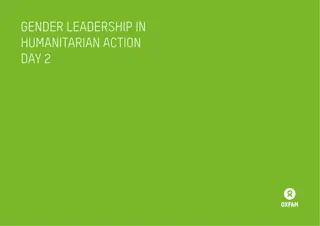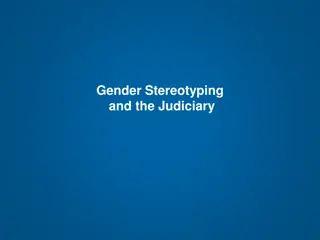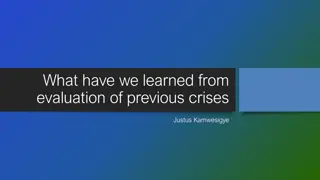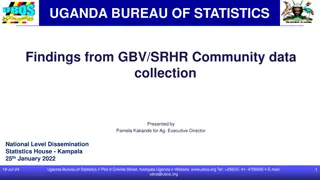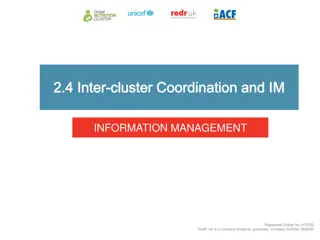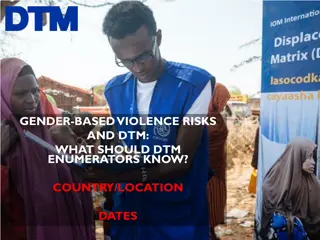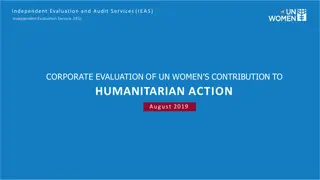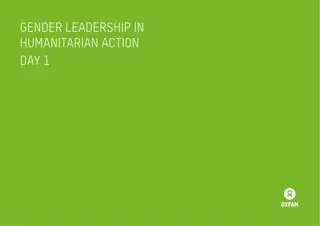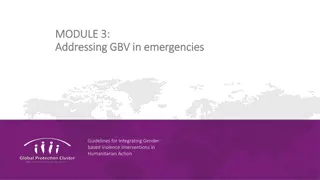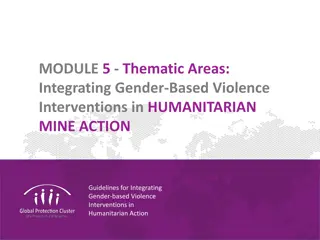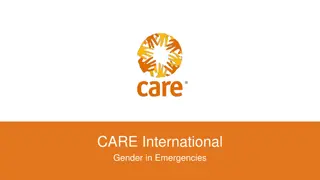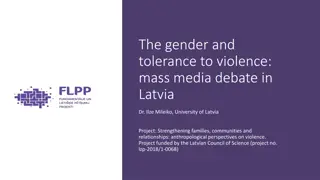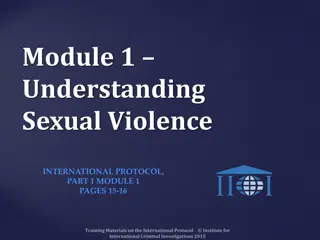Gender-Based Violence in Humanitarian Emergencies Overview
Gender-Based Violence (GBV) in humanitarian emergencies is a harmful act based on socially-ascribed differences, impacting both genders. Women face increased risks, and GBV must be addressed as an essential component of emergency response. Various forms of GBV exist in emergencies, requiring a duty to respond with prevention, resilience promotion, and aid for recovery. It is crucial for humanitarian personnel to assume GBV is occurring, treat it seriously, and take necessary actions, as outlined in guidelines.
Download Presentation

Please find below an Image/Link to download the presentation.
The content on the website is provided AS IS for your information and personal use only. It may not be sold, licensed, or shared on other websites without obtaining consent from the author.If you encounter any issues during the download, it is possible that the publisher has removed the file from their server.
You are allowed to download the files provided on this website for personal or commercial use, subject to the condition that they are used lawfully. All files are the property of their respective owners.
The content on the website is provided AS IS for your information and personal use only. It may not be sold, licensed, or shared on other websites without obtaining consent from the author.
E N D
Presentation Transcript
GENDER-BASED VIOLENCE IN HUMANITARIAN EMERGENCIES
GENDER-BASED VIOLENCE Harmful act against a person s will Based on socially-ascribed differences between females and males = gender Directed against any person female or male Majority females: 1 in 3 worldwide Different forms: sexual, physical, emotional, economic IPV most common Exists everywhere cuts across all barriers
WHATS DIFFERENT FOR WOMEN IN EMERGENCIES? More dangerous - existing vulnerabilities and inequalities exacerbated Women deliberately targeted GBV increases - communities disrupted, populations moving, no systems of protection, lack of support services Emergency services must be flexible, contextual, adaptive not same as non-emergency services GBV interventions are NOT an add-on they are essential from onset of all emergencies
FORMS OF GBV IN EMERGENCIES (GBViE) Sexual violence most immediate and dangerous Conflict-related sexual violence (CRSV) Sexual exploitation and abuse (SEA) Trafficking and forced prostitution Forced marriage Harmful traditional practices Intimate partner violence
IASC GBV GUIDELINES 1. Reduce risk = GBV prevention and mitigation in all aspects of humanitarian response 2. Promote resilience = strengthen systems to prevent and mitigate and ensure access to support 3. Aid recovery = support capacities to create lasting solutions
ASSUME GBV IS TAKING PLACE GBV is happening everywhere GBV is underreported everywhere All humanitarian personnel have the responsibility to: (1) Assume GBV is taking place (2) Treat it as a serious and life-threatening protection issue (3) Take actions described in the Guidelines to minimize GBV risk through their sectoral interventions Regardless of the presence or absence of concrete evidence
WHO ARE THE GUIDELINES FOR? Main audience: programmers who are not GBV specialists 1. Government 2. Humanitarian Coordinators 3. Humanitarian Country Teams/Inter-Cluster Working Groups 4. Cluster/Sector Lead Agencies 5. Cluster/Sector Coordinators 6. GBV Coordination Mechanisms
ELEMENTS OF ACTION 1. Assessment, Analysis and Strategic Planning 2. Resource Mobilization 3. Implementation 4. Coordination with Other Humanitarian Sectors 5. Monitoring and Evaluation Guidelines focus on prevention and mitigation MORE THAN response why?
HUMANITARIAN PROGRAM CYCLE GBV actions integrated throughout HPC Preparedness + 5 Elements 2 Enablers: Coordination Information Management
PREPAREDNESS Identifying potential risks and vulnerable groups Establishing risk mitigation measures minimizing consequences Enhancing capacity for systematic response Contingency planning Protocols and policies Prevention services and supplies Preparedness is continuous if not responding, we should be preparing!
DISASTER RISK REDUCTION Prevention + preparedness + response + recovery Linked to GBV prevention and response Capacities to prevent and respond to GBV are fundamental to reducing risk Engage women in efforts to reduce disaster risk also as decision-makers
PEACEBUILDING AND TRANSITION GBV does not end when the emergency ends new forms may emerge, work must continue Prioritize recovery to restore/improve services, livelihoods, living conditions Promote prevention and protection Ensure sustainability of GBV interventions - ensure funding for this
GLOBAL COMMITMENTS 2012: Preventing Sexual Violence Initiative (UK + UN) 2013: Safe from the Start (USA) Call to Action (UK) 2015: Call to Action Road Map (global with rotating leadership)
HUMANITARIAN CLUSTER SYSTEM Strengthens humanitarian response - predictability, accountability and partnership Cross cutting: gender, HIV&AIDS, human rights, environment Protection Cluster - Areas of Responsibility (AoRs): 1. GBV 2. Child protection 3. Housing, land and property 4. Mine action
GBV AOR Global forum co-led by UNFPA and UNICEF Promotes comprehensive and coordinated programming to prevent and respond to GBV in emergencies: 1. Supporting life-saving services 2. Building knowledge and capacity 3. Establishing norms and standards 4. Advocating for action, research, accountability global and local
INTEGRATING GBV ACROSS OTHER CLUSTERS CCCM: women's center/tent, safe living areas for single women WASH: separate facilities in different areas, safe water points Nutrition: safe breastfeeding space, information-sharing on services Livelihoods: programs for survivors and those at risk Health: services and supplies for survivors Education: teachers trained to mitigate risk Food Security: prevent SEA and transactional sex, safe distribution Shelter: safe distribution of shelter/NFIs, female-friendly spaces Telecomm: hotline for survivors, text messages for services and support
GBV COORDINATION MECHANISMS Mainstreaming GBV throughout humanitarian response Supporting development of SOPs Developing information systems for coordination Developing IEC materials Making appeals for GBV funding Building capacity of GBV partners Conducting assessments, data collection, monitoring, and knowledge management Conducting advocacy
GBV COORDINATION HANDBOOK Target audience: GBV Coordinators Individuals/agencies involved in GBV coordination For comprehensive, effective and ethical GBV programming Advocacy tool Supports risk reduction and emergency-preparedness planning
GBV INTERVENTIONS HOW? APPROACHES: 1. Human rights-based 2. Survivor-centered 3. Community-based 4. Systems-based GUIDING PRINCIPLES: 1. Safety 2. Confidentiality 3. Respect 4. Non-discrimination
GBV INTERVENTIONS MUST UNDERSTAND the causal relationship between: 1. TYPES of GBV 2. VULNERABILITIES of populations 3. NATURE and PHASE of crisis In order to: IDENTIFY available RESOURCES and ASSETS
MAINSTREAMING AND PRORAMMING Mainstreaming: Applies to ALL actors Reducing risk Providing timely, safe, ethical response Applying principles and approaches Specialized Programming: Applies to GBV specialists Direct service delivery
MULTI-LEVEL RESPONSE STRUCTURAL = Preventative measures to ensure rights are protected laws and policies SYSTEMIC = Systems and strategies to prevent, detect, monitor and respond multi-sectoral OPERATIVE = Direct services to meet the needs of survivors COMMUNITY = Community mobilization to promote and maintain social norms change
MULTI-SECTORAL RESPONSE COUNSELING & MHPSS HEALTH SURVIVOR LEGAL AID & ACCESS TO JUSTICE FAMILY POLICE & SECURITY COMMUNITY REINTEGRATION & SOCIO-ECON
HEALTH: Recognize and address GBV Administer Clinical Management of Rape (CMR) - post- rape treatment Administer Minimum Initial Service Package (MISP) in emergencies for SRH and GBV Connect with MHPSS and other services/support
COUNSELING: Address mental health needs Provide psychosocial support Promote healing Provide case management Refer to other services/support as needed
POLICE & SECURITY: Recognize and address safety and security needs Address GBV prevention and protection Ensure appropriate reporting and follow up Ensure zero tolerance Refer to other services/support as needed
LEGAL & JUSTICE: Protect survivors rights and support their access to justice Use existing laws/policies Monitor cases and judicial processes Refer to other services/support as needed
REINTEGRATION & SOCIO- ECONOMIC: Promote reintegration family, school, community, society, etc. Support livelihoods and economic empowerment Provide access to vocational training, financial lending schemes, job placement and other opportunities
PREVENTION& MITIGATION Prevention = Actions to stop GBV from occurring Education and awareness-raising Gender equality Engaging communities especially men and boys Mitigation = Actions to reduce risk of exposure to GBV Safe access to shelter, water/sanitation, food and NFIs Lighting, security patrols, etc. There is overlap example: livelihoods
STANDARD OPERATING PROCEDURES Specific procedures and agreements among organizations Minimum standards for prevention and response Plan of action and roles and responsibilities A process: capacity building + communication + building partnerships
REFERRAL SYSTEMS SURVIVOR SPEAKS Referral system = referral network + referral pathway TO SOMEONE ELSE DIRECTLY TO SERVICE PROVIDER IMMEDIATE INTERVENTION SERVICE PROVIDERS MUST: RESPECT GBV GUIDING PRINCIPLES PROVIDE IMMEDIATE SUPPORT REFER FOR URGENT CARE RECOMMEND HOLISTIC CARE NETWORK of support services for survivors ENTRY POINT: HEALTH WITHIN 72 HOURS ANYTME FOR EMERGENCY ENTRY POINT: COUNSELING REFER TO PROTECTION BASED ON SURVIVOR NEED & CHOICE REFER & ACCOMPANY PATHWAY survivor uses to access support services POLICE & SECURITY LEGAL AID & JUSTICE AFTER IMMEDIATE INTERVENTION: REFER TO OTHER SERVICES BASED ON SURVIVOR NEED & CHOICE HEALTH COUNSELING PROTECTION: POLICE & SECURITY LEGAL AID & JUSTICE BASIC NEEDS: SHELTER SAFE SPACE SOCIO-ECONOMIC SUPPORT
GBV DATA COLLECTION: ETHICS AND SAFETY 1. Benefits must outweigh risks Methodology Referral to services Safety Confidentiality Informed consent Information-gathering team Special considerations when involving children 2. 3. 4. 5. 6. 7. 8.
QUANTITATIVE DATA GBV Information Management System (GBVIMS) Common set of tools and guidelines standardizes how reported GBV case data is managed Collect, store and analyze reported GBV data safely and ethically Promotes safety, respect, dignity and consent of GBV survivors Ensures that humanitarian response to GBV will be informed by high-quality, reliable data
GBVIMS INCIDENT CLASSIFICATION 6 core incident types: 1. Rape 2. Sexual assault 3. Physical assault 4. Forced marriage 5. Denial of resources, opportunities and services 6. Psychological/ emotional abuse
GLOBAL CHALLENGES Other forms of GBV vs. sexual violence Engaging men and boys Supporting male survivors Adequately addressing at-risk groups and minorities Engaging SOGI Prevention what s working?
REGIONAL CHALLENGES Ongoing insecurity Regional and cross-border nature of emergencies Donor fatigue Lack of local capacity to prevent/respond Insufficient financial commitments to sustain interventions Short-term approach vs. long-term need Other forms trafficking, child marriage
REGIONAL RECOMMENDATIONS Seek longer-term funding to manage cyclical nature of emergencies Build local capacity for GBV programming Ensure holistic approaches that integrate multiple services/support Address all forms of GBV based on context Contextualize and translate Address cross-border challenges through multi-country programming and support
ROLE OF IWSAW 5 pillars: 1. Education 2. Research 3. Development 4. Outreach 5. LAU Engagement Integrating GBV across our work
